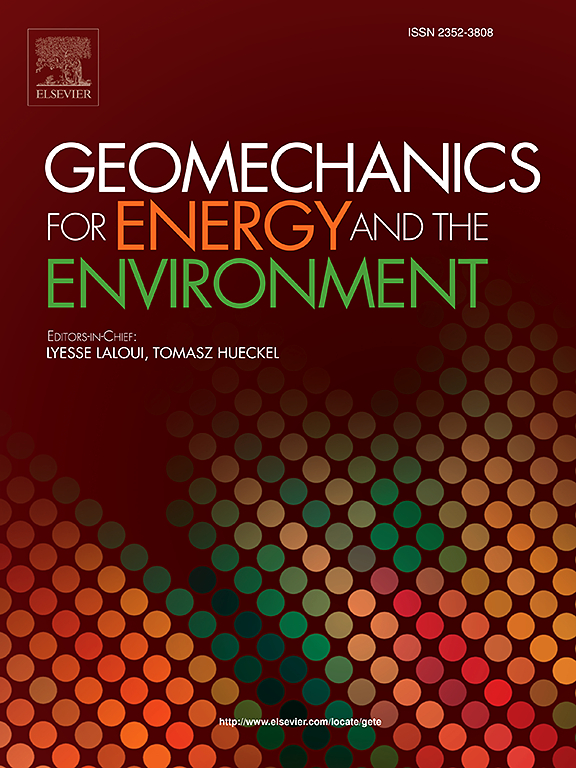注浆加固裂隙岩体渗透率演化与预测建模:一种智能计算方法
IF 3.7
2区 工程技术
Q3 ENERGY & FUELS
引用次数: 0
摘要
注浆加固裂隙岩体的渗透演化特征对地下工程渗流稳定控制具有重要影响。本研究采用高压三轴试验系统制备了不同围压(0-10 MPa)条件下的裂隙砂岩试件。采用煤矸石-粉煤灰基注浆进行加固,系统测量了注浆前后有效应力(1 ~ 9 MPa)下的渗透率变化。采用粒子群算法(PSO)、遗传算法(GA)和灰狼优化算法(GWO)建立了注浆岩体渗透率预测模型,并开发了交互式计算平台。结果表明:灌浆后渗透率较灌浆前降低54.83 ~ 99.75 %,随有效应力的增加呈幂律递减;利用断裂应力状态、初始渗透率、注浆参数等6个关键因素,构建了80个样本的训练数据集。利用GWO优化的BP神经网络(6-7-1拓扑)实现了高精度的渗透率预测(R2 = 0.997, MAE = 0.051)。最后,开发了一个集参数控制、模型计算和结果可视化于一体的基于python的智能交互计算系统。这为工程注浆设计提供了理论支持和技术工具。本文章由计算机程序翻译,如有差异,请以英文原文为准。
Permeability evolution and predictive modeling in grout-reinforced fractured rock masses: An intelligent computational approach
The permeability evolution characteristics of grout-reinforced fractured rock masses significantly influence the seepage stability control in underground engineering. In this study, fractured sandstone specimens under various confining pressures (0–10 MPa) were prepared using a high-pressure triaxial testing system. Reinforcement was performed using coal gangue-fly ash-based grout, and the permeability variations under effective stresses (1–9 MPa) were systematically measured before and after grouting. A permeability prediction model for grouted rock masses was established by employing swarm intelligence algorithms (Particle Swarm Optimization (PSO), Genetic Algorithm (GA), and Grey Wolf Optimizer (GWO)), and an interactive computational platform was developed. The results show that post-grouting permeability decreased by 54.83–99.75 % compared to pre-grouting values, exhibiting a power-law decline with increasing effective stress. Using six key factors—including fracture stress state, initial permeability, and grouting parameters—an 80-sample training dataset was constructed. A backpropagation (BP) neural network (6-7-1 topology) optimized by the GWO achieved high-precision permeability prediction (R2 = 0.997, MAE = 0.051). Finally, a Python-based intelligent interactive computing system was developed, integrating parameter control, model computation, and result visualization. This provides theoretical support and technical tools for engineering grout design.
求助全文
通过发布文献求助,成功后即可免费获取论文全文。
去求助
来源期刊

Geomechanics for Energy and the Environment
Earth and Planetary Sciences-Geotechnical Engineering and Engineering Geology
CiteScore
5.90
自引率
11.80%
发文量
87
期刊介绍:
The aim of the Journal is to publish research results of the highest quality and of lasting importance on the subject of geomechanics, with the focus on applications to geological energy production and storage, and the interaction of soils and rocks with the natural and engineered environment. Special attention is given to concepts and developments of new energy geotechnologies that comprise intrinsic mechanisms protecting the environment against a potential engineering induced damage, hence warranting sustainable usage of energy resources.
The scope of the journal is broad, including fundamental concepts in geomechanics and mechanics of porous media, the experiments and analysis of novel phenomena and applications. Of special interest are issues resulting from coupling of particular physics, chemistry and biology of external forcings, as well as of pore fluid/gas and minerals to the solid mechanics of the medium skeleton and pore fluid mechanics. The multi-scale and inter-scale interactions between the phenomena and the behavior representations are also of particular interest. Contributions to general theoretical approach to these issues, but of potential reference to geomechanics in its context of energy and the environment are also most welcome.
 求助内容:
求助内容: 应助结果提醒方式:
应助结果提醒方式:


